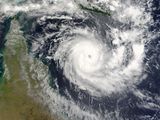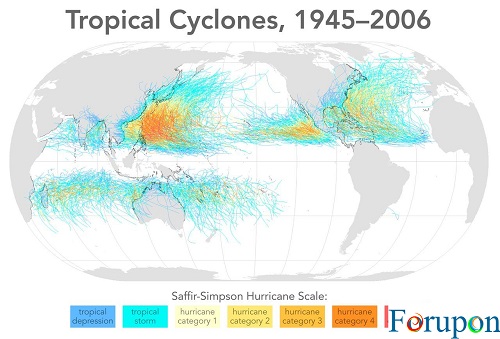The Coriolis Effect: Earth’s Rotation and Its Effect on Weather
The Coriolis effect describes the pattern of deflection taken by objects not firmly connected to the ground as they travel long distances around the Earth.
What is the Coriolis Effect?
What is the Coriolis effect?
For upon |The Coriolis Effect downloaded from PBS LearningMedia, https://www.pbslearningmedia.org/resource/nvcl.sci.earth.coriolis/the-coriolis-effect/. The rights to use this asset do not expire. © 2014 WGBH Educational Foundation. All Rights Reserved. The material contained in this product is based upon work supported by NASA under cooperative agreement award No. NNX16AD71A. Any opinions, findings, conclusions, or recommendations expressed in this material are those of the author(s) and do not necessarily reflect the views of the National Aeronautics and Space Administration.
Hurricane Isabel
The deflection associated with the Coriolis effect leads storms in the Northern Hemisphere (like Hurricane Isabel spinning above Puerto Rico here) to swirl counterclockwise.
Cyclone Ingrid
In the Southern Hemisphere, winds pass from high-pressure systems to low-pressure systems on the left. This makes storms, such as Cyclone Ingrid, storming across northern Australia above, appear to swirl in a clockwise direction.
Tracking Tropical Cyclones
Storm paths are partly determined by the Coriolis effect. In the Northern Hemisphere, most tropical cyclones blow toward the west. The Coriolis effect leads these storms to ultimately veer to the right, as seen in this beautiful map. (This is also a great chance to see the absence of the Coriolis effect in equatorial regions.)
Jovian Belts
On Jupiter, the Coriolis effect actually transforms north-south winds into east-west winds, some traveling more than 610 kilometers per hour (380 miles per hour). The divisions between winds that blow mostly to the east and those that blow mostly to the west create clear horizontal divisions, called belts.
Coriolis Effect
Coriolis Effect
The Coriolis effect describes the pattern of deflection taken by objects not firmly connected to the ground as they travel long distances around Earth. The Coriolis effect is responsible for many large-scale weather patterns.
The key to the Coriolis effect lies in Earth’s rotation. Specifically, Earth rotates faster at the Equator than it does at the poles. Earth is wider at the Equator, so to make a rotation in one 24-hour period, equatorial regions race nearly 1,600 kilometers (1,000 miles) per hour. Near the poles, Earth rotates at a sluggish 0.00008 kilometers (0.00005 miles) per hour.
Let’s pretend you’re standing at the Equator and you want to throw a ball to your friend in the middle of North America. If you throw the ball in a straight line, it will appear to land to the right of your friend because he’s moving slower and has not caught up.
Now let’s pretend you’re standing at the North Pole. When you throw the ball to your friend, it will again appear to land to the right of him. But this time, it’s because he’s moving faster than you are and has moved ahead of the ball.
Everywhere you play global-scale “catch” in the Northern Hemisphere, the ball will deflect to the right.
This apparent deflection is the Coriolis effect. Fluids traveling across large areas, such as air currents, are like the path of the ball. They appear to bend to the right in the Northern Hemisphere. The Coriolis effect behaves the opposite way in the Southern Hemisphere, where currents appear to bend to the left.
The impact of the Coriolis effect is dependent on velocity—the velocity of Earth and the velocity of the object or fluid being deflected by the Coriolis effect. The impact of the Coriolis effect is most significant with high speeds or long distances.
Weather Patterns
The development of weather patterns, such as cyclones and trade winds, are examples of the impact of the Coriolis effect.
Cyclones are low-pressure systems that suck air into their center, or “eye.” In the Northern Hemisphere, fluids from high-pressure systems pass low-pressure systems to their right. As air masses are pulled into cyclones from all directions, they are deflected, and the storm system—a hurricane—seems to rotate counter-clockwise.
In the Southern Hemisphere, currents are deflected to the left. As a result, storm systems seem to rotate clockwise.
Outside storm systems, the impact of the Coriolis effect helps define regular wind patterns around the globe.
As warm air rises near the Equator, for instance, it flows toward the poles. In the Northern Hemisphere, these warm air currents are deflected to the right (east) as they move northward. The currents descend back toward the ground at about 30° north latitude. As the current descends, it gradually moves from the northeast to the southwest, back toward the Equator. The consistently circulating patterns of these air masses are known as trade winds.
Impact on Human Activity
The weather impacting fast-moving objects, such as airplanes and rockets, is influenced by the Coriolis effect. The directions of prevailing winds are largely determined by the Coriolis effect, and pilots must take that into account when charting flight paths over long distances.
Military snipers sometimes have to consider the Coriolis effect. Although the trajectory of bullets is too short to be greatly impacted by Earth’s rotation, sniper targeting is so precise that a deflection of several centimeters could injure innocent people or damage civilian infrastructure.
The Coriolis Effect on Other Planets
The Earth rotates fairly slowly, compared to other known planets. The slow rotation of Earth means the Coriolis effect is not strong enough to be seen at slow speeds over short distances, such as the draining of water in a bathtub.
Jupiter, on the other hand, has the fastest rotation in the solar system. On Jupiter, the Coriolis force actually transforms north-south winds into east-west winds, some traveling more than 610 kilometers (380 miles) per hour.
The divisions between winds that blow mostly to the east and those that blow mostly to the west create clear horizontal divisions, called belts, among the planet’s clouds. The boundaries between these fast-moving belts are incredibly active storm regions. The 180-year-old Great Red Spot is perhaps the most famous of these storms.
The Coriolis Effect Closer to Home
Despite the popular urban legend, you cannot observe the Coriolis force by watching a toilet flush or a swimming pool drain. The movement of fluids in these basins is dependent on the manufacturer’s design (toilet) or outside forces such as a strong breeze or the movement of swimmers (pool).
You can observe the Coriolis force without access to satellite imagery of hurricanes, however. You could observe the Coriolis effect if you and some friends sat on a rotating merry-go-round and threw or rolled a ball back and forth.
When the merry-go-round is not rotating, rolling the ball back and forth is simple and straightforward. While the merry-go-round is rotating, however, the ball won’t make it to your friend sitting across from you without significant force. Rolled with regular effort, the ball appears to curve or deflect, to the right.
Actually, the ball is traveling in a straight line. Another friend, standing on the ground near the merry-go-round, will be able to tell you this. You and your friends on the merry-go-round are moving out of the path of the ball while it is in the air.

Storms in the north swing counter-clockwise: the Coriolis force. Storms in the south wing with the clock, and winds tend to pass to the left!
Photograph courtesy NASA, Jeff Schmaltz, MODIS Land Rapid Response Team at NASA GSFC
Coriolis Force
The invisible force that appears to deflect the wind is the Coriolis force. The Coriolis force applies to movement on rotating objects. It is determined by the mass of the object and the object’s rate of rotation. The Coriolis force is perpendicular to the object’s axis. The Earth spins on its axis from west to east. The Coriolis force, therefore, acts in a north-south direction. The Coriolis force is zero at the Equator.
Though the Coriolis force is useful in mathematical equations, there is actually no physical force involved. Instead, it is just the ground moving at a different speed than an object in the air.


Comments are closed.